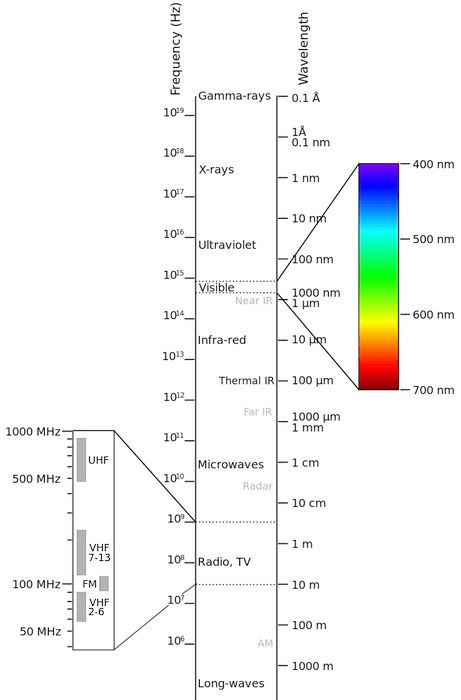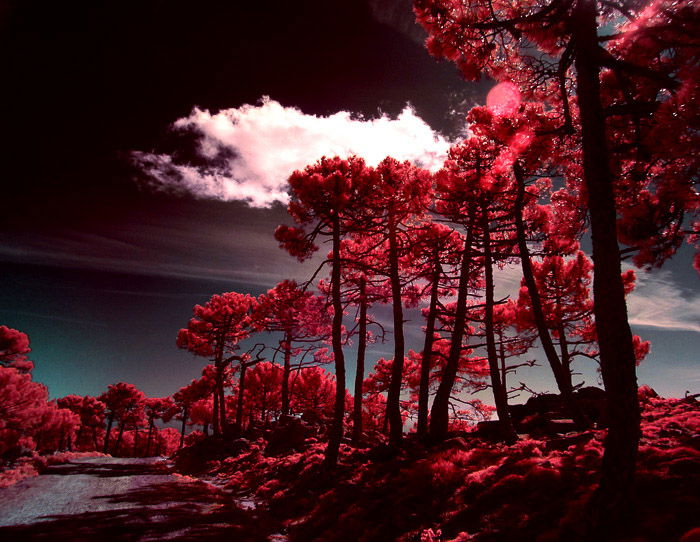As a photographer, you want to surprise your audience. Your ultimate goal is to produce images that will cause people to take a second look. Regardless of genre or topic.
This is why I love infrared photography. Read the article below to get started too.
I don’t always have the ability to travel everywhere I want to. This means that I can find my local landscapes underwhelming at times.
So here’s what I did to get over that:
I found a small, simple and cheap piece of equipment. This allows me to make common scenes’pop’. By making the “invisible”, “visible”.
The act of ‘seeing’ involves mapping the environment we are in. According to the kind (and intensity) of light, reflected by the objects surrounding us.
Yet, there is much more out there than what we can perceive with our natural senses. These are past the visible light spectrum.
When we speak about the light we see, we are talking about electromagnetic waves. These are lying within very specific ranges of frequencies (or wavelengths).
We called this ensemble of waves the ‘visible’ region of the electromagnetic spectrum. With higher frequencies than visible light, we have ultraviolet (UV) light. At lower frequencies, we find the infrared light.
At times we can sense infrared as heat on our skin, rather than with our eyes.

Capturing a photograph using IR light is what makes the invisible, visible.
While not new, infrared photography is not common, particularly nowadays. For further history and uses of IR photography, refer to Wikipedia.
Our vision is often better than that of our cameras. Particularly when it comes to dynamic range. This is the level of brightness we can perceive.
But we cannot see IR light – the sensor of your Nikon or Canon camera can. This is why we can create digital infrared photography.
You buy a photo camera for the ability to snap attractive, infrared pictures of what you see. Mixing visible and infrared light will degrade the image quality of your camera. You don’t want that, right?
Camera manufacturers do not want that either, so they place a filter in front the sensor to block IR light.
Infrared filters can stop you from creating infrared red images.
Luckily, no filter is bulletproof. Some IR light still reaches your sensor. This means we can do IR photography with straight-out-of-the-box (SOOTB) digital cameras. Even if there are some compromises to accept.
The effect of the IR blocker placed in front of the digital sensors is the same as using a 10 stops neutral density filter.
In both cases you are reducing the amount of light that will hit the sensor in a given amount of time.
To expose your infrared photos you must keep the shutter open for a longer time. In the end, infrared photography with a SOOTB camera, is long exposure photography.
If you want to regain full control over your shutter speeds, you have two options:
Option 1 is usually quite expensive. You will be replacing the IR blocker with a filter. So you will also not be able to use your camera for anything other than IR photography.
Option 2 is more flexible, but it may be challenging, too. Infrared films, such as the Ilford SFX 200 Infrared B&W, may be scarce. And you will probably have to deal with a fully manual DSLR camera.
Also, finding a photo lab able to properly develop such a film may be difficult. Digital infrared photography may be the way to go.

Most electronic systems (in-camera light meters and handheld light meters) and exposure rules (sunny 16 rule, etc.) work with visible light in mind.
IR scenes may require a different exposure. Ensure that you do some bracketing before calling it a day.
Also, Infrared photography can fool your autofocus. If you are using an unmodified camera, it is like trying to use the AF to focus on a subject at night. Inside a dark room.
You are better off with manual focus as focus speed should not be an issue in this scenario anyway. Digital infrared photography allows you to do this.
And then there’s the infamous infrared “hot spot”. Lenses are built with visible light in mind. Due to the internal coating of the lens barrel of some lenses, an IR Hot Spot will appear in your images.
A hot spot generally appears circular, in the middle of the frame. It is brighter than the surrounding part of the image. And it has a different tint/color temperature.
Lens quality varies and performances may differ depending on the aperture value used. Wider apertures are often better than narrow ones.
You can correct faint hot spots during editing.

Using your TV remote control, hold down a button and point it at your camera. Can you see (or photograph) the light coming from the remote IR emitter?
If you can, then you are good to go!
The brighter you can see the IR emitter, the better it is. Even though this means that the IR blocker installed in your camera is not really that efficient.

Landscape photographers swear by the golden and blue hours. This is to take advantage of the best quality of natural light.
If you are like me, with a family and a 9 to 5 job, chances are that you are not going to see many golden/blue hours. It is also unlikely that you can chase storms to capture the most dramatic skies.
But the IR golden hour is midday Capturing great digital infrared photography is much more achievable.
Infrared photography has the inherent WOW factor of displaying familiar scenes in a new way.
The photo below was taken in a park outside of Brussels, on a sunny Sunday in July, at around 1pm.


The most common subjects for IR photography are landscapes. That’s because they can appear unusual and unexpected.
Water and blue skies absorb IR light. But grass, large-leaf trees and puffy clouds reflect IR light. The essence of an IR image is the contrasts between objects absorbing or reflecting IR light.
Pine and spruce trees absorb quite a lot of IR light. Try a black and white conversion of your IR photo. You will see a black sky with puffy white clouds, black water, dark grey pine trees and white leaves and grass.






Editing your infrared photos will take few extra steps than usual. How many, will depend on the final result you want to achieve.
Below, is a typical raw file obtained with an unmodified camera, using the HOYA r72 IR filter.

Black and white IR conversions are less surprising at first. But you will still perceive that something is not quite right.
Below, you can see the pond when converted to black and white from visible and IR light. The giveaway detail is the foliage, which is white in the conversion from IR.


A false color IR conversion screams ‘weird’. You can’t be fooled, something is going on here.
The most simple thing you can do is play with the white balance. Try to make the areas that should be white or black, their respective colors.
You will have an image with a general orange tone. Surprise!





I hope that this post has inspired you and it will help you to unleash your creativity.
I find that infrared photography is brilliant for the unexpected results I can get.
It has the power to make your audience connect with your work. Especially when you show them the unseen beauty of places they go past every day.




